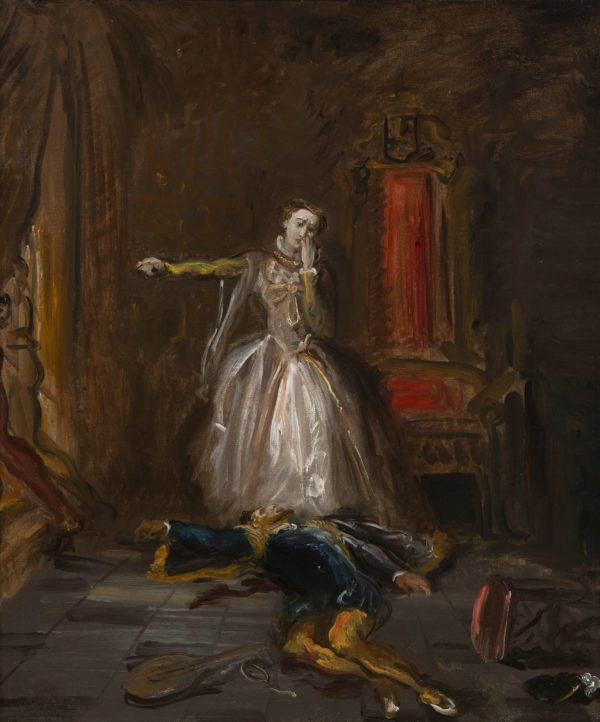Mary Stuart swearing Revenge, c. 1849
Oil on canvas, H. 0.65 m; W. 0.55 m
Vente Théodore Chassériau stamp on the stretcher
Provenance: Sale Chassériau, March 16, 1857, no. 16 (Marie Stuart jurant la vengeance)
Otto Skaller, Berlin
Sale Berlin, Paul Graupe, November 13, 1930, no. 3
Sale Berlin, Internationales Kunst-und Auktionshaus, February 2, 1932, lot 356
Probably Chassériau sale, Paris, June 14, 1944 (titled Portrait de Mlle Alice Ozy)
André Derain, Chambourg
Galerie Charpentier, Paris, André Derain sale, March 22, 1955, lot 63, Alice Ozy dans le rôle de Marie Stuart. Peint en 1845 (unsold)
Sale Paris, Hôtel Drouot, June 24, 1955 (75000 francs)
Claus Virch, New York
Private collection
Théophile Gautier, “Atelier de feu Théodore Chassériau”, L’Artiste, VIe Série, XIII, March 15, 1857, p. 211 (cites among the most important works Marie Stuart jurant la vengeance)
Valbert Chevillard, Un peintre romantique, Théodore Chassériau, Paris, 1893, no. 138.
Marc Sandoz, Théodore Chassériau 1819-1856, catalogue raisonné des peintures et estampes, Paris, 1974, p. 216, no. 104 (as Marie Stuart Jurant La Vengeance also known as Portrait de Mlle. Alice Ozy), as “unknown location, probably in the United States”.
Louis-Antoine Prat, “Théodore Chassériau: œuvres réapparues”, Revue de l’Art, no. 125, 1999, p. 71-74.
In 1974 when Marc Sandoz published the catalogue raisonnné of Chassériau,((Marc Sandoz, Théodore Chassériau 1819-1856, catalogue raisonné des peintures et estampes, Paris, 1974, p. 216, no. 104.)) the precise location of our painting was unknown, it was assumed to be in a private collection in the USA. In 1999, Mr. Louis-Antoine Prat((Louis-Antoine Prat, “Théodore Chassériau : œuvres réapparues”, Revue de l’Art, no. 125, 1999, p. 71-74.)) identified and published the painting, specifying its connection with studies in a sketchbook at the Louvre. These drawings, doubtless made directly from actors on a stage, evoke the period of Mary Stuart. On the verso of folio 3 there is a drawing connected with Mary Stuart’s costume in our painting. A study on the verso of folio 5 shows Riccio’s lute, abandoned on the ground. Chassériau probably saw a performance of Schiller’s play Marie Start at the Théâtre Français in 1845. Could the actress Alice Ozy (1820-1893), Chassériau’s lover from 1849, have played the part of Mary Stuart as Marc Sandoz claimed? It seems that the young actress, a friend of Théophile Gautier who later introduced her to Chassériau, was still under contract with the Théâtre du Vaudeville until 1847. But it is tempting to find in the Mary Stuart of our painting the actress’s features, which are also visible on the Bather Sleeping near a Spring, 1850, in the Musée Calvet in Avignon.
The scene shown here does not appear in Schiller’s play, which concentrates on Mary Stuart’s tragic destiny; nor in Donizetti’s opera Maria Stuarda which premiered in Paris in 1845. Chassériau was doubtless stimulated by all these performances but the source on which he relied to create this painting remains unknown.
Our painting reflects the historical reality of this Catholic princess who had been wife of François II and queen of France for only a year (1559-1560) before becoming queen of Scotland. Mary Stuart had to face the worst difficulties as soon as she arrived in her new kingdom: the fanaticism of the pastor John Knox, the hostility of Anglicans, unrest among the nobility, plots fomented against her by Elizabeth I of England who was afraid she would claim her rights to the English crown. In 1561, Mary Stuart refused the offer of marriage of the Duke of Ferrara whose disappointed ambassador left her a musician who entertained her, David Riccio. After the failure of another marriage prospect with Don Carlos, a son of Philip II of Spain, she married her own cousin, Lord Darnley. Riccio who took on the role of secret counsellor supported this union. Lord Darnley quickly proved to be a bitter husband, a drunkard and a rake, and was gradually rejected by Mary. He then plotted, with the help of the protestant lords, to have Riccio assassinated. This is the episode shown here: on 9 March 1566, the Conspirators erupted into the room where Mary was dining with her favourite and a few ladies-in-waiting and killed Riccio in front of the queen. The murderers have just left the room. We still see the legs of two of them on the far left, showing the steps of a staircase.
Mr. Louis-Antoine Prat has compared our painting to some small rapidly executed works dating around 1850: The Toilet of Desdemona in Strasbourg (about 1849), The Death of Romeo and Juliet in the Louvre. He assumes that the Louvre sketchbook was reused later and suggests dating our painting around 1849.
